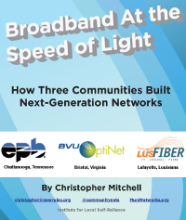
Fast, affordable Internet access for all.

We have already published a fact sheet on the critical role community broadband plays in job development. Now, ILSR presents a collection of how community owned broadband networks save money for local government, schools, and libraries while providing cutting edge services. The Public Savings Fact Sheet is now available.
Though schools, libraries, and other community anchors need access to faster, more reliable networks, the big cable and telephone companies have priced those services so high that they are breaking the budget. But when communities create their own connections, affordable high capacity connections are only one of the benefits. A community owned network offers the promise of self-determination -- of upgrades on the community's time table and increased reliability for emergency responders.
The Public Savings Fact Sheet is a great piece to share to mobilize other members of your community. Share it with decision makers and use it to start meaningful conversations. Distribute it widely and often.
We are always developing new resources. If you have an idea for a new fact sheet, we want to hear it.


It’s harder to profit from the investment in broadband infrastructure in rural areas where fewer residents live further apart. Among poorer residents, broadband – and even newspaper subscriptions – tend to be luxuries for job seekers or people who are still trying to rebuild homes damaged by Hurricane Katrina nearly seven years ago. The Picayune’s decision to print only three days a week means fewer newspapers will get passed around local barber shops, beauty salons, cafes and convenience stores — places where many people who don’t have broadband access at home often go to exchange information about what’s happening in their neighborhoods.Access to the Internet becomes more important every day but our policymakers continue to rely on some of the most hated corporations in the nation (with good reason) to deliver it. And they continue to fail. Communities should continue investigating how they can take greater responsibility for solving their problems locally.
Vidalia, a Louisiana town with 4,300 residents, is a small town with a big idea. Vidalia one of the poorest regions in the country with an unemployment rate hovering around 9.4% so area leaders seek new ways to improve opportunity. The Vidalia Broadband Initiative aims to connect every home with a gig and provide 10 gig capacity for every business connection.
From a June, 2011 Natchez Democrat story:
“We realize the importance of being connected to the Internet,” [City Manager Ken Walker] said. “And the only way to really meet the need to ensure adequate Internet access is through direct fiber optics to each building.”
Along with other communities in the region, Vidalia anticipated using part of a 2010 Broadband Technology Opportunities Program (BTOP) grant for $80 million to build their network, estimated at $9 million. But the entire BTOP grant was revoked when it became apparent that the Governor's Administration intended to violate the rules of the grant by giving the new infrastructure to big carriers that had no intention of adhering to the open access rules.
Vidalia decided to forge ahead and seek funding on their own. The community is seeking out a variety of funding sources, including UDSA Rural Utility grants. In the meantime, Vidalia is taking advantage of any and all opportunities to invest in fiber assets.
The town has its own electrical utility and wants to develop a smart-grid. The City has been actively involved with negotiations with a local telephone and data company to provide service, but is planning on an open access model hoping to encourage competition. The City's long term goal is to provide fiber to each home in Vidalia and give residents a choice of providers. Right now, there are two providers in the community and service is described as "often slow and interrupted."

LUS Fiber now offers its business subscribers the current ultimate in broadband speeds. An April 5th press release from LUS Fiber reports that business customers of the state's only community-owned ftth network now have access to 1 gig symmetrical internet connections.
The ability to offer such fast speeds in both directions is a big draw to business customers, boosting the potential for economic development. In the press release:
“Gigabit service from LUS Fiber is one of the most robust Internet offerings on the market today,” says Terry Huval, Director of Lafayette Utilities System and LUS Fiber. “We built this community network with a promise to the people of Lafayette that we will work hard to provide them with new opportunities through this unique, state-of-the-art fiber technology…and that’s just what we’ve done.”
We have reported extensively on events surrounding the development of, and contiued corporate attack on, the LUS Fiber system. The local Lafayette Pro Fiber Blog reporter, John, notes how this advancement is rare in the US because the LUS 1 gig service can be offered to all business customers, not just those considered part of a "business core."
John also provides an excellent analysis of how LUS Fiber uses a different customer service approach than traditional ISPs. While he reports on engineering details, he also dicusses a key policy difference between providing the best service and providing any service:
Oversubscription and "best effort" is the name of the game for almost all ISPs and the bandwidth available to the last mile customer is in practice limited: if all subscribers were to use their full bandwidth at once the available speed would drop to a small fraction of the promised bandwidth. LUS has always played that game a different way, minimizing oversubscription and ensuring that even during busy hours of the day the customer's full bandwidth is available. That's in marked contrast to what I used to experience on Cox when the kids in my neighborhood got off the bus.
The battle over broadband in Lafayette is part of a growing number of clashes across the USA that pit municipalities against telecom firms for the right to deliver Web access to homes and businesses. More than 150 local governments across the country have built or are planning to build cyber networks, says Christopher Mitchell of the Washington-based Institute for Local Self-Reliance, a non-profit group that advocates community development and local access to technology. Mitchell says those efforts often draw opposition in the form of misinformation campaigns, lawsuits from private providers or unfavorable state laws resulting from telecom lobbying. Nineteen states either ban cities and counties from getting into the broadband business — or make it difficult.Minor quibble: the Institute for Local Self-Reliance (and particularly my work) is not Washington-based. Like the toy in Crackerjack boxes, we cannot have a story about community networks without at least one blatant lie from some cable company employee. No disappointments here:
"Our initial objection was, and remains, that it is an unfair advantage for your competitor to also be your regulator," says Todd Smith, a Cox spokesman. "Many states prohibit government from competing with the private sector."I challenge Todd Smith to name one way in which LUS Fiber regulates Cox. When the local government makes rules that impact either Cox or LUS Fiber, such rules have to be non-disciminatory or they violate state and federal laws. If incumbents think the community is violating any laws, we know that they know how to hire lawyers and file lawsuits.

This Digital Divide committee is motivated by the vision of our community creating a future in which everyone is both able to and motivated to seize the full power of a fiber optic network. Such a network has the potential to transform the lives of citizens in ways similar to the deployment of electricity, radio, and television. In building its own fiber-optic based utility, Lafayette creates the opportunity for further unifying the people of this community and, potentially, to help bridge current divides among her citizens. A publicly owned network can lower barriers to full and equal participation by making a new and powerful communication technology available to every citizen at the lowest practical cost. In our times, the keys to participation and productivity lie in these rapidly developing technologies. We recognize that if Lafayette is to experience healthy growth and benefit fully from such new technologies, all her people will need to become equal partners in our endeavor. Lowering the barriers to such a partnership and engaging in vigorous and innovative educational efforts will help us realize our community’s full potential. Barriers preventing entry into the world of computers and the World Wide Web include low income, fear or suspicion of technology, a lack of understanding of how useful technology can be, and absence of instruction concerning computers and the Internet. In addition, transportation to places where computers and Internet access are available to the public and knowledge that such places even exist are barriers for some.